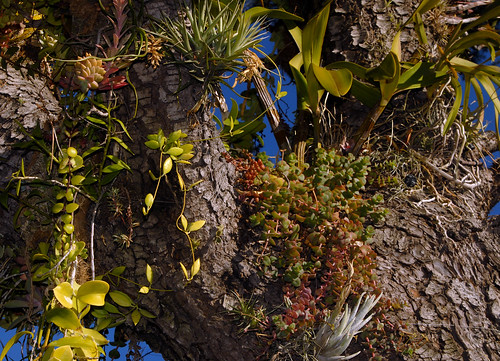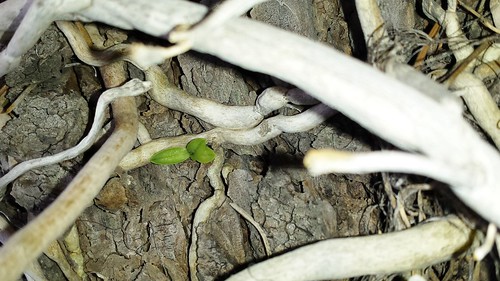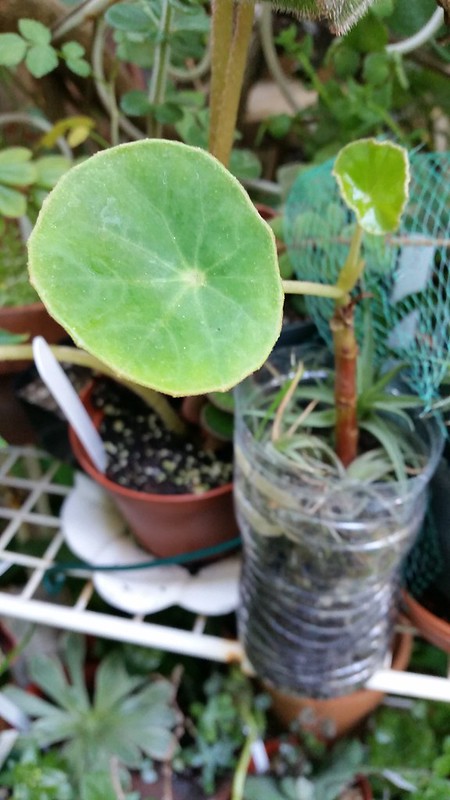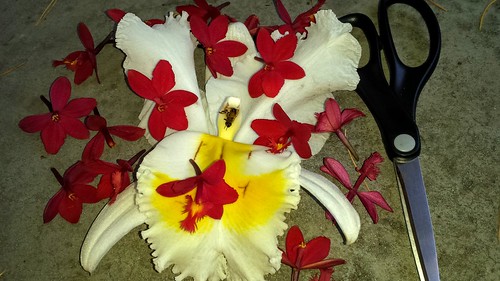******************************************
Your teacher asked me to share with you some of my thoughts about economics, which you’re currently covering in school. She knows that it’s my very favorite thing in the world. Why do I love economics even more than I love epiphytes? Well, it’s because epiphytes, and everything else that I love, all depend on economics.
Right now there are several Tillandsia aeranthos blooming at your school. The reason why these epiphytes are beautifying your school is because you’ve cared for them, and also because I decided to share them with your teacher. Where did mine come from? They came from my tree where they had grown from wind-dispersed seeds, which came from plants that I had received from a friend. Around a decade ago I drove up to Oregon and picked up a big collection of Tillandsias from my friend Dale. He had a giant greenhouse primarily dedicated to orchids, but thanks to the really excellent air movement, the Tillandsias were taking over. They were growing on the walls, floors, benches, pots… they were even growing on the orchids. So I helped “weed” the Tillandsias and he let me have them. I piled them in the back of my truck and drove them back home. The Tillandsias, especially aeranthos, were happy in their new home and over the years I’ve shared, sold and traded the extras.
Where did Dale get his Tillandsia aeranthos from? I don’t know. Maybe he received them from a friend, or maybe he bought them, or maybe he traded for them. But I do know that Tillandsia aeranthos originally came from Brazil. This is where it is native to.
How Tillandsia aeranthos traveled from the trees in Brazil to the trees at your school in California is an economic story. It involves many people over the years deciding that it was worth it to spend their time growing this epiphyte. Each new grower helped Tillandsia aeranthos, as a species, hedge its bets. This economic story doesn’t end at your school. Several of you already took some home… and perhaps a few of you have already shared some with other people.
What about your new school? I’m guessing that it doesn’t already have any Tillandsia aeranthos... is this a problem? You’ll have to decide whether it’s worth it to try and grow this epiphyte at your new school. This decision depends on weighing the costs and the benefits. On the one hand, you’ll have to take the time to water them, but on the other hand, they’ll help beautify the school and make it more interesting. Plus, they’ll provide food for hummingbirds and shelter for other animals, which would make your school even more interesting.
There are a few different types of cost… the most important type is known as opportunity cost. All the time that you spend watering Tillandsia aeranthos is time that you can’t spend doing other things. Because your time is limited, naturally you want to put it to its most beneficial uses. The idea that society’s limited resources should be put to their most beneficial uses is known as Quiggin’s Implied Rule of Economics (QIRE).
Let’s say that you determine how much benefit that you’d personally gain from having Tillandsia aeranthos growing on trees at your new school. What about all the other students and teachers? According to QIRE, it matters how much benefit they would gain from this, but it’s not like you can read their minds.
Therefore, when it comes to economics, one of the most important things is the communication of benefit. In order to maximize beneficial behavior, we need to inform others how much benefit we derive from their behavior. There are two ways that we can express benefit… words and actions. The main difference is that actions require a sacrifice, words do not. Naturally we like to use words to communicate benefit but, because they don’t involve any sacrifice, they aren’t very reliable.
I’ll share an economics joke with you. Two economists are walking along when they happen to end up in front of a Tesla showroom. One economist points at a shiny new car and says, “I really want that!” The other replies, “You’re lying”. This joke is funny because if the one economist had truly wanted the car then he would have walked in and bought it. Evidently, given that he didn’t do so, the (opportunity) cost was too high for him. He had more beneficial uses of his limited money.
Here’s one of the most useful passages on the subject…
If a woman told us that she loved flowers, and we saw that she forgot to water them, we would not believe in her "love" for flowers. Love is the active concern for the life and the growth of that which we love. Where this active concern is lacking, there is no love. - Erich Fromm, The Art of Loving
It’s easy to say that we love something, or someone, but love can only be reliably quantified and expressed by sacrifice. The more time that you're willing to spend growing and promoting Tillandsia aeranthos, the greater your love for it.
As an extra credit assignment you can visit Rainforest Flora. They offer a wide selection of Tillandsias, so you might be as happy as a kid in a candy store. Walk around the sales area and make a list of all the Tillandsias that match your preferences, and then compare it to the list of all the Tillandsias that you actually buy. How different are the two lists? The owners of the nursery might be interested to know all the Tillandsias that you like, but what they are truly interested to know is which Tillandsias you actually love. The Tillandsias that you genuinely love are the ones that you are willing to spend your money on. The owners would take this more reliable feedback and use it to try and improve their selection of Tillandsias. If, for example, you and other customers buy more Tillandsia aeranthos hybrids, then the owners would spend more of their time creating more of them, and this would make the customers happier. Everybody who visits Rainforest Flora has the freedom to use their money to help grade all the different products. This is what makes it a market.
What would happen if you asked the owners to simply give you some Tillandsias for free? Perhaps they might be willing to give you one or two, especially if you buy a dozen. However, they’ll be much more inclined to give you free Tillandsias if you explain that they will be used to beautify your new school. It will certainly help if you show them a blog entry that has pictures of the Tillandsia aeranthos that are now blooming on trees at your current school. You’d inform the owners that you would also use the blog to document your mission to beautify your new school with Tillandsias.
The Tillandsias that are growing on trees at your school are a public good. But the ones at your home are a private good. The difference is the amount of people that can enjoy them. Of course if your Tillandsias at home are in the front yard where everybody can see them, then they would also be a public good. The same exact good, in this case a Tillandsia, can be a private good or a public good depending on where it is grown.
Just like the owners of Rainforest Flora are naturally going to be more inclined to give Tillandsias away if they know that they are going to be used to beautify a school, the same is also true of the members of the La Ballona Valley Bromeliad Society.
Last Fall the owner of Sunset Valley Orchids, Fred Clarke, was kind enough to donate a big box of orchids to help beautify your current school. Future blog entries that document his orchids growing and blooming on trees at the school should recognize and acknowledge his generous contribution.
People are happy to voluntarily contribute to beneficial causes… but our society doesn’t solely rely on donations to pay for public goods. We primarily rely on taxes. People are forced to pay taxes because the amount of money that people would donate to public goods would be significantly less than their true perception of their benefit. It's certainly a problem when spending doesn't reliably communicate benefit. Yet, everybody's taxes are spent by elected representatives.
Strange as it might seem, there’s no scientific evidence that it’s beneficial to allow elected representatives to spend everybody’s taxes. It would theoretically be far more beneficial for each and every taxpayer to have the freedom to choose where their taxes go. Since people wouldn't have the option to spend their taxes on private goods, their spending decisions would reliably communicate the amount of benefit that they received from public goods. Those of us who love botanical gardens, for example, would be able to allocate our taxes to them. Of course, every school should be a botanical garden!
Unlike Rainforest Flora, our government is not a market. Neither is Netflix. Each month each subscriber pays $10 dollars and Netflix decides how to divide this money among all its shows and movies. What would happen if, all else being equal, each and every subscriber was given the freedom to decide for themselves how they divide their money among the content? What difference would it make if 100 million subscribers, each one with a unique set of preferences and knowledge, could use their money to help grade the content? Would the supply of nature shows worsen, improve or stay the same if Netflix was a market?
The reason why people can reasonably disagree about the effectiveness of markets is because there’s a severe scarcity of scientific evidence. Therefore, reasonable people should strongly agree that it’s imperative to scientifically test different economic systems. Every experiment is essentially a product, so a better understanding of economics would mean more scientific progress… as well as a better supply of shows, epiphytes and everything else.
Education itself is a bundle of different products. In school I remember wondering about the usefulness of these products. Recently an economist by the name of Bryan Caplan wrote a controversial book arguing that many of these products are useless...
Anyone who scrutinizes modern schools with a mildly cynical eye witnesses piles of material students are laughably unlikely to use in adulthood. The fat emerges in kindergarten: history, social studies, art, music, foreign language. By high school, as we've seen, students spend at least half their time on fat. In college, many majors are made of fat: think history, communications, or "interdisciplinary studies." About 40% of graduates earn degrees in comically - or tragicomically - useless subjects. Even the hardest majors burn ample time on high theory and breadth requirements. - Bryan Caplan, The Case against Education
The people who disagree with Caplan's book, which is itself an educational product, inherently agree that educational products aren't equally beneficial. In order to ensure that students learn the most beneficial things, everybody should have the freedom to use their money to help grade educational products. This logically makes economics the most beneficial thing to learn. But it wouldn't be beneficial for everybody to actually become an economist. With this in mind, I’ll leave you with the most beneficial passage from the most beneficial book…
It is thus that the private interests and passions of individuals naturally dispose them to turn their stocks towards the employments which in ordinary cases are most advantageous to the society. But if from this natural preference they should turn too much of it towards those employments, the fall of profit in them and the rise of it in all others immediately dispose them to alter this faulty distribution. Without any intervention of law, therefore, the private interests and passions of men naturally lead them to divide and distribute the stock of every society among all the different employments carried on in it as nearly as possible in the proportion which is most agreeable to the interest of the whole society. — Adam Smith, Wealth of Nations












